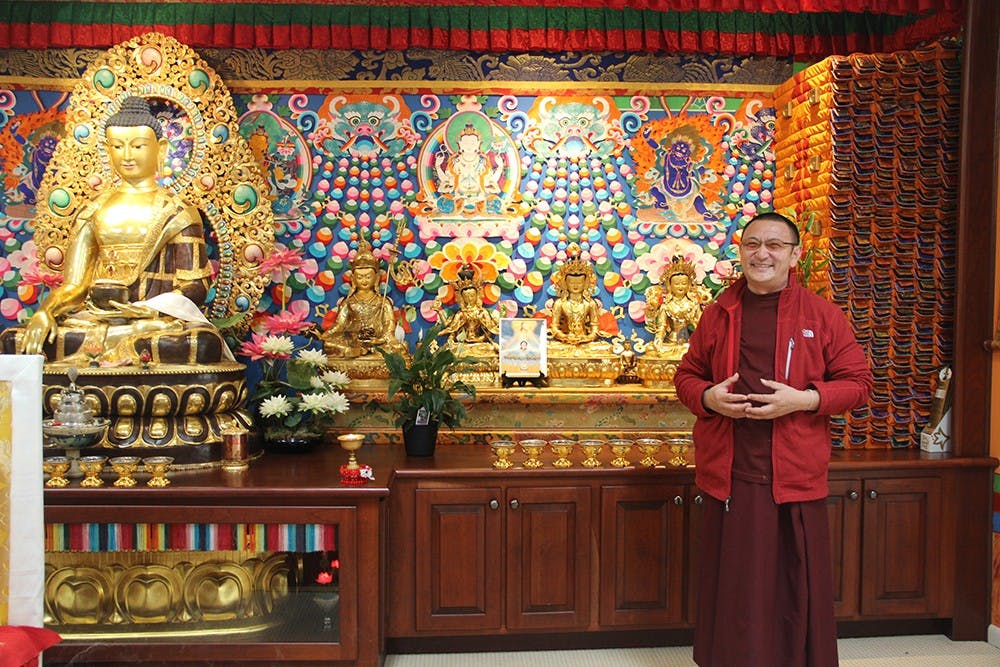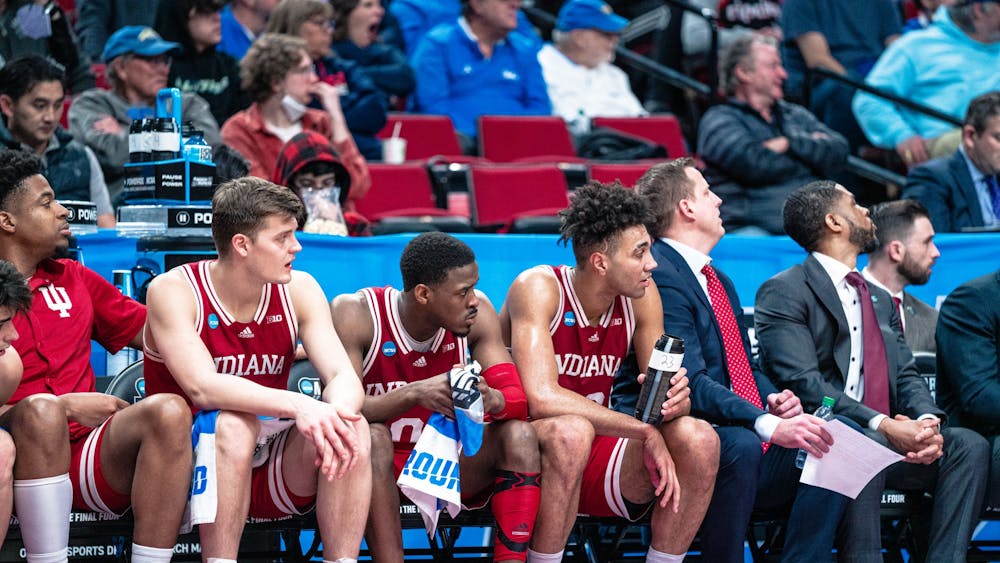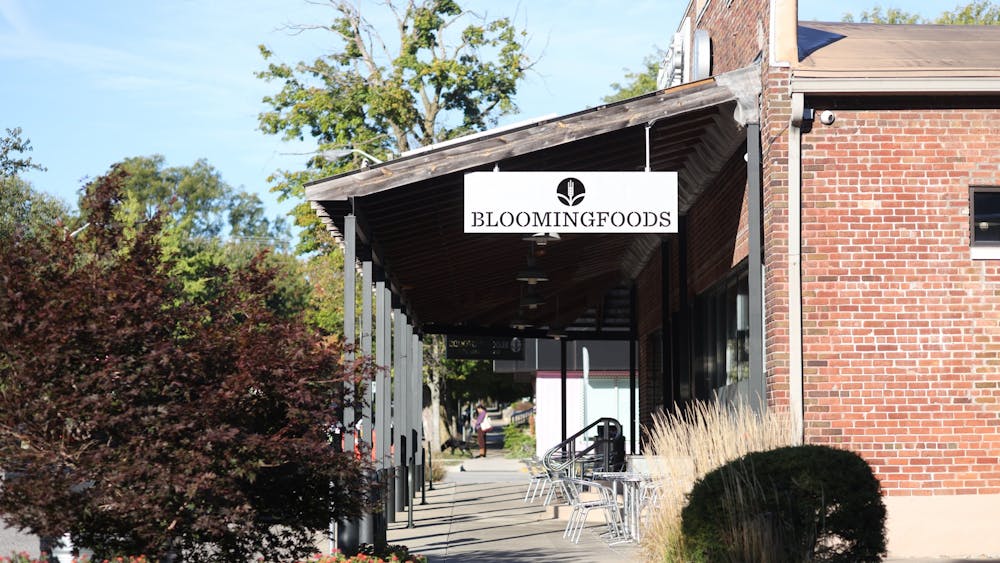But the home at 3655 Snoddy Road is different.
Kumbum Chamtse Ling Monastery is home for Tibetan Buddhist Monks who dedicate their lives to studying and living Buddhist teaching. It’s also home to the Tibetan Mongolian Buddhist Cultural Center, a place where the general public can gather to pray, take yoga classes and listen to Buddhist teachings. The center and the monastery have been in existence since 1979, when a former monk and IU professor built the center hoping to preserve Tibetan culture and religion.
It’s easy to miss the entrance if driving fast. A painted wooden gate and signs are the only evidence that the center and monastery exist on the road. But once you turn in, a paved, hilly drive leads directly to the cultural center.
The drive passes a large garden, a long rectangular building dedicated for prayer and monuments that house colorful mandalas—geometric artwork made of sand. The atmosphere is markedly different from the rest of the city: except for the sounds of nature, or on the days that a monk rides a lawnmower, the property is pervasively silent.
Geshe Kunga La is a monk who works in the cultural center. On Monday, he sat in a chair reading a book by the Dalai Lama, pausing to greet visitors. He makes sure people remove their shoes before entering and stresses the openness of the area so people of other faiths do not feel uncomfortable.
“The Buddhist temple is not the only temple,” he said.
Those that come to the cultural center come primarily for one room in the middle—the “Big Room”—a small auditorium where they can pray or where lessons are had. At the entrance, a basket is brimming with sheets of pink paper. A note taped on the front asks people to write the names of people so that monks can pray for them.
The walls are orange with blue and green additions and gold Tibetan lettering. Beaded portraits hang there, artwork that Kunga said took an American Buddhist monk three years to create.
At the front, several golden Buddhist figures look out at the expanse of the room. A couple of them have money at their feet.
Kunga said the money was an offering and that Americans were more likely to leave money as gifts, instead of other things like food.
“Westerners are different,” Kunga said.
In one sense, it is nothing new: a holy place filled with images of respected figures, artwork and opulent decoration. But it differs significantly from other religions in one area: Buddhism is not the only religion represented. The stage is flanked with two displays that hold religious paraphernalia of varied faiths: Judaism, Hinduism, Christianity, Islam and more.
“It does not matter whichever God you pray to,” Kunga said. “Buddha said we are all alike in one way: everybody thinks about good luck, no suffering.”
Kunga said his statements reflect the current Dalai Lama’s take on faiths and people around the world and it’s a take that Libby Harpring said she believes in.
“His message is so simple and yet so profound,” Harpring said. “We have to start respecting each other and loving each other and be in our best mind.”
Hapring came to the cultural center from Indianapolis with a group of friends meeting for their high school reunion.
“I’ve learned to appreciate very much the Buddhist philosophy of peace and oneness, so I thought it would be a good idea to bring my high school friends,” Harpring said.
The Dalai Lama is the front of the uniting messages of Buddhism, but a hospital visit in late September sparked an international furor as people wondered if his health was failing - and if it was, who his successor would be, who would carry on the messages he’s used to inspire people across the globe.
“It’s possible there won’t be [another] Dalai Lama,” Kunga said. “Tibetan people choose if they need a Dalai Lama.”
Kunga said the reach of the Dalai Lama’s message extends to Bloomington: he’s seen various religious people gather to pray and meet at the cultural center.
“Sometimes they come to meditate,” Kunga said.
Buddhism is classified as a religion, but there isn’t a single “God” that Buddhists follow. Informational pamphlets from the cultural center say that traditional Buddhist images are of concepts such as wisdom so that “they can better realize their presence,” not so they can be worshiped.
The monastery lies beyond the cultural center, and isn’t open to the public. Kunga said that monks come from around the world to study and learn Buddhism in Bloomington. The garden along the drive is tended by the studying monks, and they take care of their own landscaping.
“Some food we eat, some food we give,” Kunga said. “Someone will mow the grass, someone will cut down trees.”
Kunga teaches Buddhism at the monastery when he’s not at the cultural center. He knew from a young age that he wanted to be a monk and that he wanted to teach, but moving to Bloomington was never something that crossed his mind.
Kunga said he was born in 1964 and said the Tibet he grew up in was like North Korea is today: isolated from the rest of the world.
“I saw the monks, and I wanted to be one of them,” Kunga said.
He joined a monastery and began studying Tibetan history, writing and Buddhism. Eventually he and six other monks decided they were going to try to see the Dali Lama in India. But none of them had passports.
“We couldn’t take the bus,” Kunga said. “We would have been stopped at the border.”
So they walked.
“We walked for 24 days and crossed the Himalayan mountains,” Kunga said.
For three of the last days, they had nothing to eat.
“We only drank tea,” he said. “Before, in Tibet, I was like ‘oh I like this food and don’t like that food.’ I wasn’t like that anymore.”
When he and the other monks finally arrived, he said there were 37 other people waiting to see the Dalai Lama. They waited for three weeks to meet with him. The Dalai Lama informed Kunga that he was transferring to a monastery in Mongolia. Eventually, he saw the Dali Lama once more and learned he was transferring again to Bloomington in 2010.
“I’m still learning English,” he said. “Old people have a harder time learning new languages.”
Even so, he said he speaks Hindi, Tibetan and some Chinese in addition to English.
The cultural center operates primarily on its own. Recently, Unity of Bloomington hosted an event with Tibetan Buddhist monks who were on a world tour, but center administrator Danielle Bachant-Bell said that no other partnerships are planned for the near future.
“We may hope to do something with them again, but that was our first opportunity to partner with the cultural center,” Bachant-Bell said.
The cultural center is a non-profit - none of its activities or classes cost money. Similar to other churches, a teaching is held on Sunday at 10:30. Kunga said he teaches that class. Meditation instruction happens twice a week on Mondays and Thursdays. The monks also make themselves available to create mandalas for those who request them, along with butter sculptures for alters and prayer flags.
All of this is important to Buddhists, especially those who dedicate their lives to the religion at the monastery. But Kunga regularly acknowledges the religious diversity of the world and the openness of Tibetan Buddhism.
“His holiness says, ‘any,’” Kunga said.






